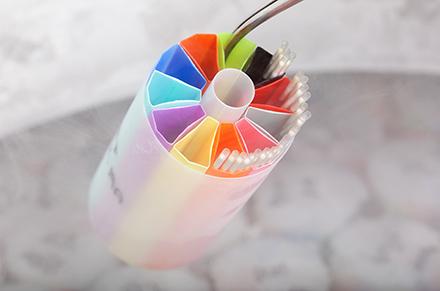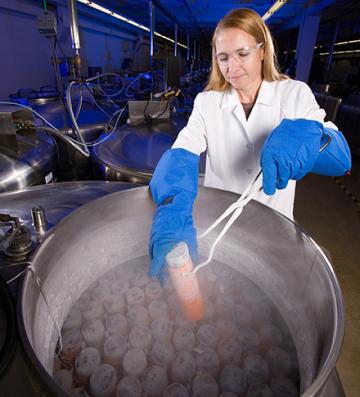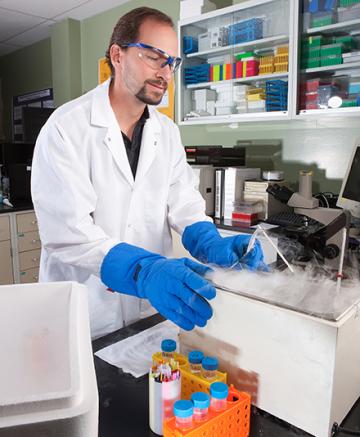Could Extinction Become Extinct?

Above are semen straws stored in a goblet in a liquid nitrogen tank for long-term storage. Storing straws in this format and the corresponding information in the database facilitate the efficient finding of samples from a specific animal. (Peggy Greb, D3765-2)
Loss of genetic variation used to be a one-way street – once lost, there was no way back. That’s not necessarily the case now, at least for American farm animals.
Scientists with the Agricultural Research Service (ARS) in Fort Collins, CO, maintain a one-of-a-kind collection that’s designed to preserve the biodiversity of animal agriculture. “Our genetic resources underpin the livestock sector’s ability to ensure food security and promote economic vitality,” said Harvey Blackburn, national coordinator of the ARS National Animal Germplasm Program (NAGP).
The livestock industry contributes billions of dollars to national and local economies, so it is imperative that scientists have access to a broad array of genetic resources for the reintroduction of genetic variability. It is genetic variability that enables the animals to adapt to changes in the environment and, potentially, new diseases.

ARS animal support scientist Carrie Wilson retrieves a goblet of animal germplasm samples from a liquid nitrogen tank where they are kept in long-term storage. Samples are stored at -196° C. (Peggy Greb, D3764-1)
Blackburn’s team fulfills its mission in three ways: operating a database to manage information on animals held in the collection, evaluating genetic diversity of various livestock breeds and populations, and the cryopreservation of gametes and tissues to preserve the genetic diversity of animal populations. Gametes are sperm and egg cells that contain a single set of chromosomes that may unite with a gamete of the opposite sex to form a zygote – a fertilized egg. Cryopreservation is the process of freezing a cell to about -300 F using a controlled freezing rate. The cells are placed in a chemical solution that minimizes injury during the freezing and thawing processes.
While loss of biodiversity can be tragic in nature, it could be absolutely devastating to American agriculture and consumers. For years, farmers and ranchers have selectively bred livestock that met the greatest consumer demand – hens that lay more eggs, large-breasted turkeys, faster growing beef cattle, and dairy cows that give more milk are just a few examples. By design, selective breeding eliminates genetic diversity. However, some useful genes can be inadvertently lost, too.
If a catastrophic event were to occur, such as a disease that devastated a farm animal population, it wouldn’t take long for it to effect food security or the economy. Currently, porcine reproductive and respiratory syndrome (PRRS) is a major worldwide concern. PRRS causes reproductive failure, pneumonia, and increased risk of secondary bacterial infection. The annual economic loss to PRRS approaches $700 million, but there’s hope – there is a known genetic variation that resists PRRS. Such genetic variability can be collected and stored in the national collection.

ARS animal technician Scott Spiller thaws an animal germplasm sample for evaluation. All samples frozen at the ARS National Laboratory for Genetic Resources Preservation are thawed and evaluated for their viability prior to long-term storage. (Peggy Greb, D3766-1)
“NAGP provides a critical backup for production agriculture’s genetic resources base,” Blackburn said.
One such example is NAGP’s effort to diversify the nation’s herd of Holstein cattle. Researchers in 2015 discovered that, due to selective breeding, the male lines of 99% of nearly 10 million dairy cows could be traced back to only two bulls. NAGP scientists were also able to reintroduce two different lost Y chromosomes into the Holstein dairy cattle breed, thereby increasing the genetic variability available for dairy producers to use.
NAGP also works with the U.S. Fish and Wildlife Service and the Smithsonian to store backup collections of genetic materials for endangered fish and coral. Internationally, NAGP supports Jersey cattle from Jersey Island located in the English Channel, the UN Food and Agriculture Organization, the Brazilian Agricultural Research Corporation, Mexico, France, the Netherlands, and Agriculture and AgriFoods in Canada.
Overall, there are more than 1.1 million samples in the collection from over 57,000 animals that represent 171 breeds. – by Scott Elliott, ARS Office of Communications
You May Also Like

